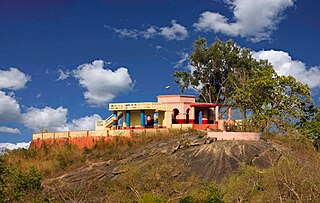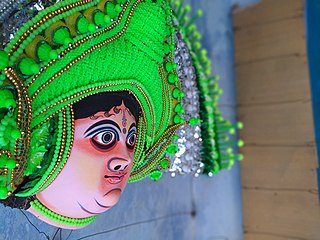
The music of West Bengal includes multiple indigenous musical genres such as Baul, Ramprasadi, Bishnupuri Classical, Kirtan, Shyama Sangeet, Rabindra Sangeet, Nazrul Geeti, Dwijendrageeti, Prabhat Samgiita, Agamani-Vijaya, Patua Sangeet, Gambhira, Bhatiali, Bhawaiya, Bengali Rock.

Gombhira is a type of song originating in the Bengal region in the eastern part of the Indian subcontinent, what is today northeastern West Bengal, India and northwestern Bangladesh.

Chhau dance, also spelled Chhou dance, is a semi classical Indian dance with martial and folk traditions. It is found in three styles named after the location where they are performed, i.e. the Mayurbhanj Chhau of Odisha, the Seraikella Chhau of Jharkhand, and the Purulia Chhau of West Bengal.

The Geography of West Bengal, a state in eastern India, is primarily defined by plains and plateaus, with the high peaks of the Himalayas in the north and the Bay of Bengal to the south.

Jhalda is a city and a municipality in Purulia district in the Indian state of West Bengal. It is the headquarters of the Jhalda subdivision.
Tulin is a village and a gram panchayat in the Jhalda I CD block in the Jhalda subdivision of the Purulia district in the state of West Bengal, situated beside the Subarnarekha River.

Baghmundi is a community development block that forms an administrative division in the Jhalda subdivision of the Purulia district in the Indian state of West Bengal.
Baghmundi is a village, with a police station, in the Baghmundi CD block in the Jhalda subdivision of the Purulia district in the state of West Bengal, India.

Dhokra is non–ferrous metal casting using the lost-wax casting technique. This sort of metal casting has been used in India for over 4,000 years and is still used. One of the earliest known lost wax artefacts is the dancing girl of Mohenjo-daro. The product of dhokra artisans are in great demand in domestic and foreign markets because of primitive simplicity, enchanting folk motifs and forceful form. Dhokra horses, elephants, peacocks, owls, religious images, measuringbowls, and lamp caskets etc., are highly appreciated. The lost wax technique for casting of copper based alloys has also been found in China, Egypt, Malaysia, Nigeria, Central America, and other places.
Sholapith or shola pith is a dried milky-white spongey plant matter from Aeschynomene species. It can be pressed and shaped into objects of art, or for practical use. It is the "pith" used for pith helmets, so giving them their name.
Kotshila is a village, with a police station and a railway junction station, in the Jhalda II CD block in the Jhalda subdivision of the Purulia district in the state of West Bengal, India.
Masina is a village in the Jhalda I CD block in the Jhalda subdivision of the Purulia district in the state of West Bengal, India.
Patardi is a village in the Baghmundi CD block in the Jhalda subdivision of the Purulia district in the state of West Bengal, India.

The Indian state, West Bengal has a rich and cultural heritage. Due to the reign of many different rulers in the past, arts and crafts in West Bengal underwent many changes giving an artistic diversity today in the forms of traditional handicrafts, terracotta, painting and carving, dances and music.

The Chhau mask is a traditional cultural heritage of Purulia in the Indian state of West Bengal. The Chhau mask of Purulia is registered on the List of Geographical Indications. As the basic difference of Purulia Chhau the mask is unique and traditional.
Jargo is a village in the Ilu Jargo panchayat in the Jhalda I CD block in the Jhalda subdivision of the Purulia district in the state of West Bengal, India.
Jiudaru is a village in the Jhalda II CD block in the Jhalda subdivision of the Purulia district in the state of West Bengal, India.

Charida is a village in the Baghmundi CD block in the Jhalda subdivision of the Purulia district in the state of West Bengal, India.
Agharpur is a village in the Joypur CD block in the Jhalda subdivision of the Purulia district in the state of West Bengal, India.





















